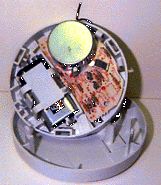This smoke detector uses the radioactive isotope Americium as a detection device.

Radioactivity is found in the home. The news media has reported on the problem of radon, Rn, buildup in our homes. However, the news reports failed to mention that Rn is a naturally occurring nuclear decay product. It is a daughter element of uranium and thorium.
All around us natural deposits of uranium, 235U (0.7% abundance) and 238U (99.3% abundance) and thorium, 232Th are decaying and producing many progeny. We ourselves are radioactive. Our intake of food will sometimes have traces of radioactive elements. Potassium-40 is found in many foods such as bananas and salt substitutes.
 |
To demonstrate to the student that some household items are radioactive.
| Materials | Counts Per Minute |
|---|---|
| Lantern mantle | |
| Pottery glaze | |
| Smoke detector | |
| Watch | |
| Glass crystal |
| Radioactive source | Isotopes | Radiation(s) | Gamma ray energy | Notes |
|---|---|---|---|---|
| Lantern mantle | 232Th | alpha rays & beta & gamma rays | 0.240 MeV | natural |
| Pottery glaze | 235U, 238U | alpha rays & beta & gamma rays | 0.063 MeV | natural |
| Smoke detector | 241Am | alpha rays & beta & gamma rays | 0.059 MeV | man-made |
| Painted watch | 226Ra | alpha rays & beta & gamma rays | 0.0510 MeV | natural |
| Glass crystal | ?Pb | ? | ? MeV | ? |
This document was produced by the Nuclear Science Division of the Lawrence Berkeley National Laboratory.